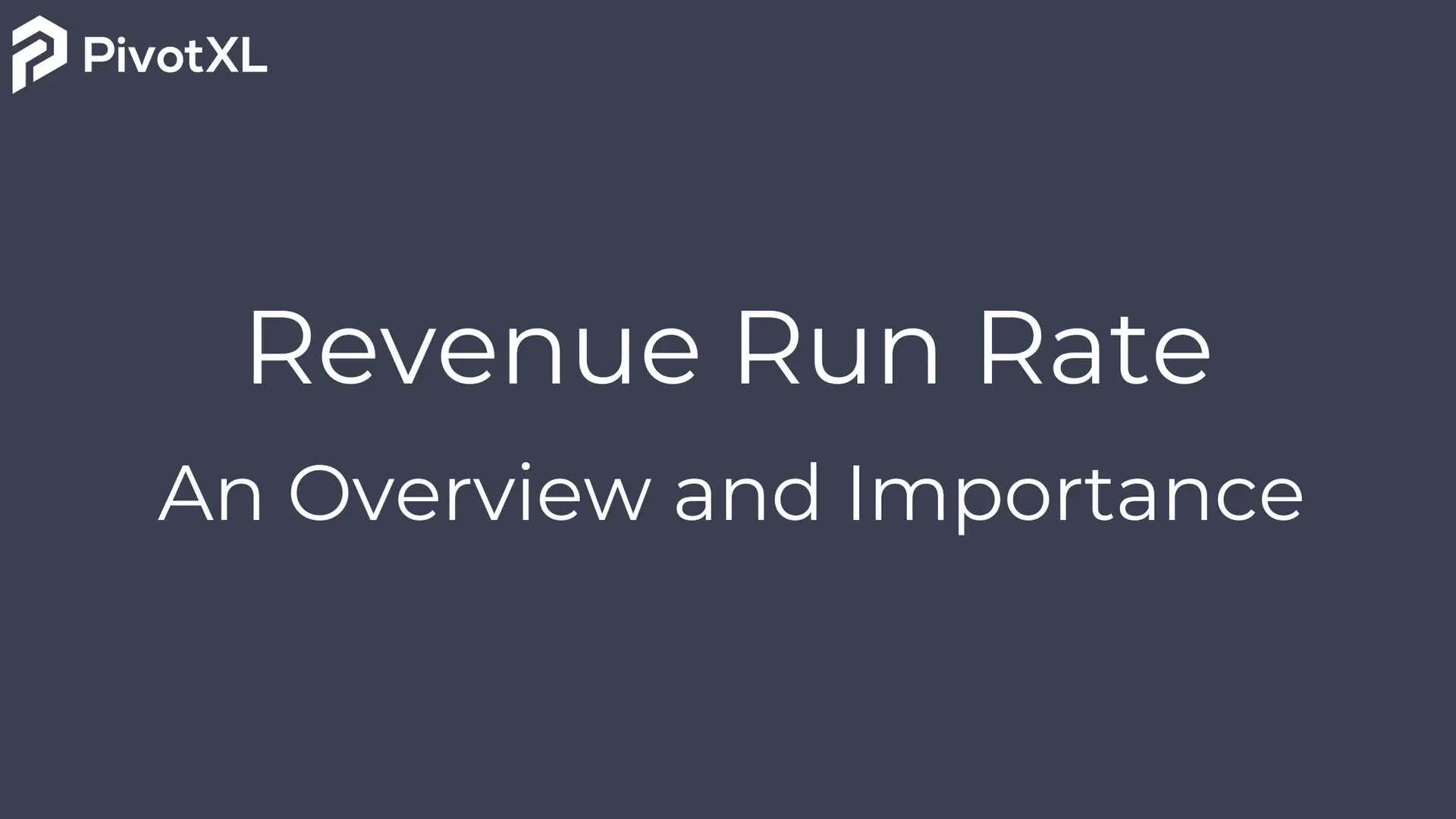Introduction
For SaaS companies, revenue forecasting is crucial to financial planning and growth strategy. One of the simplest and most commonly used metrics to estimate future revenue is the revenue run rate.
But what exactly is the revenue run rate, and how can it help your business make better financial decisions? In this article, we’ll explore the definition, formula, benefits, limitations, and best practices for using run rate. We’ll also explain how PivotXL makes revenue tracking and forecasting easier and more accurate.
Why You Should Track Your Revenue Run Rate
Tracking run rate consistently provides businesses with critical insights into financial performance. Here’s why it’s important:
1. Quick Estimation of Annual Recurring Revenue (ARR)
SaaS businesses rely on ARR to measure predictable, subscription-based revenue. Run rate helps estimate ARR quickly, though it should be combined with other SaaS metrics for greater accuracy.
2. Helps Investors Assess Growth Potential
Investors use run rate as a simple metric to evaluate growth. By comparing historical run rates with the current run rate, they can assess whether a company is accelerating, stagnating, or declining.
3. Essential for Capacity Planning
By estimating run rate, businesses can plan ahead for hiring, infrastructure expansion, and product development. Forecasting revenue helps ensure that the company has enough resources to sustain growth.
4. Supports Continuous Financial Planning
Run rate allows businesses to make rolling forecasts, adjusting projections based on real-time performance rather than relying solely on annual budgeting.
How to Calculate the Revenue Run Rate
Calculating run rate is simple, but using the right time period is crucial. The formula is:
Revenue Run Rate = Total Revenue during a Given Period × Number of Such Periods in a Year
Example 1: Monthly Revenue Run Rate
If a SaaS company generates $250,000 in revenue in January, the annual run rate would be:
Revenue Run Rate = 250,000 × 12 = 3,000,000
Example 2: Quarterly Revenue Run Rate
If the company makes $750,000 in Q1, the annual run rate would be:
Revenue Run Rate = Quarterly Revenue × 4
Example: Revenue Run Rate = 750,000 × 4 = 3,000,000
Longer periods provide smoother projections, as they reduce the effect of short-term fluctuations.
How to Use the Revenue Run Rate
Businesses use run rate in several ways:
1. Forecasting Future Revenue
Run rate helps estimate where revenue will land at year-end, assuming current trends continue.
2. Benchmarking Against Competitors
Comparing revenue run rates with industry peers provides insight into market position and competitive performance.
3. Assessing Growth Strategies
Companies can use run rate to measure the impact of sales initiatives, marketing campaigns, or product launches on revenue.
Drawbacks of Using the Revenue Run Rate
While the run rate is a simple and quick way to estimate future revenue, it comes with significant limitations. Since it relies only on historical data from a limited period, it does not account for various factors that could affect a company’s future revenue performance. Below are the key drawbacks of using run rate as a forecasting metric:
1. Does Not Account for Seasonality
Revenue patterns in many businesses, especially SaaS companies, fluctuate based on seasonal trends. For example, a company might experience higher sales during specific periods, such as the end of a fiscal quarter or the holiday season, while other months might have lower-than-average revenue.
Since the revenue run rate simply annualizes revenue from a selected period, it does not consider these seasonal variations. If the run rate is calculated using data from a peak season, it may overestimate revenue for the year. Conversely, if the calculation is based on a slow season, the run rate may underestimate potential revenue.
2. Does Not Account for Churn
Churn is a critical factor for SaaS businesses, as it measures the number of customers who stop using a service within a given period. The revenue run rate assumes that revenue growth will remain steady and does not adjust for customer churn.
If a significant portion of customers cancel their subscriptions in the future, the actual revenue will be lower than what the run rate predicts. This makes run rate an incomplete metric for long-term financial planning, as it does not reflect the impact of customer retention or loss.
3. Can Present Unrealistic Numbers in Tough Economic Conditions
The run rate does not factor in external economic conditions that could impact future sales. Economic downturns, recessions, or unexpected market disruptions can lead to lower sales volumes, reduced customer spending, and longer sales cycles.
For instance, if a company calculates its run rates during a period of strong economic growth, the projected annual revenue might be overly optimistic. However, if a downturn occurs, the company may fall short of its revenue expectations. Since the run rate is based only on past revenue trends, it does not anticipate potential economic downturns or market slowdowns.
4. Assumes Capacity Remains the Same
A company’s revenue-generating capacity is not static—it can change due to various factors, such as workforce expansions, product improvements, or infrastructure upgrades. However, the run rate assumes that the company’s current capacity remains unchanged throughout the year.
For example, if a SaaS company plans to hire more sales representatives or expand its marketing efforts, its future revenue potential will likely increase. Conversely, if the company downsizes its operations or experiences hiring slowdowns, revenue growth may stagnate. Since the run rate does not adjust for changes in business capacity, it may overestimate or underestimate actual revenue performance.
5. Does Not Account for One-Time Revenue Windfalls
A company might experience a temporary spike in revenue due to a one-time event, such as:
- A large enterprise customer signing a high-value contract
- A major promotional campaign driving an unusual surge in sales
- A short-term partnership or licensing deal
If the run rate is calculated using a period that includes such one-time revenue spikes, the annualized projection will be artificially inflated. This can lead to overly optimistic revenue forecasts that do not accurately reflect long-term trends.
6. Does Not Account for New Business ARR
For SaaS companies, Annual Recurring Revenue (ARR) is a key metric that accounts for ongoing subscription revenue. However, revenue run rate calculations do not consider new business ARR that may be generated from upcoming product launches, customer expansions, or market penetration strategies.
If a company is about to introduce a new product or enter a new market, future revenue may increase significantly beyond what the current run rate suggests. Since the run rate is based only on past revenue, it does not incorporate potential growth from new business initiatives.
When Should You Use the Revenue Run Rate?
Despite its limitations, the run rate can still be a useful metric when used appropriately. Here are some scenarios where it can provide valuable insights:
1. When Seeking Funding for a New Company
Startups and early-stage businesses often lack historical financial data to present to investors. In such cases, run rates can offer a quick estimate of growth potential based on current revenue performance.
Investors may use the run rate as a starting point to assess a company’s ability to scale, provided that market conditions remain stable. However, it is important to supplement the run rate with additional metrics such as customer acquisition cost (CAC), lifetime value (LTV), and gross margin to provide a more comprehensive financial picture.
2. When Evaluating the Impact of a New Strategy
Companies that are undergoing strategic changes—such as restructuring their sales team, launching new marketing campaigns, or expanding into new markets—can use the run rate as a benchmark to measure short-term results.
For example, if a SaaS company implements a new pricing model or enhances its customer onboarding process, it can track changes in run rates to determine whether these strategies are positively influencing revenue growth.
However, since the run rate does not account for external factors like churn and seasonality, it should be used alongside other performance indicators to validate strategic decisions.
3. When Providing Quick Insights for Sales and GTM Teams
Sales and Go-To-Market (GTM) teams often need fast, easy-to-understand metrics to evaluate performance and set revenue targets. The revenue run rates provides a simple snapshot of projected annual revenue, which can be useful for short-term decision-making.
For instance, if a SaaS company’s monthly run rates suggests it is on track to meet its annual revenue goal, sales teams can assess whether their current pipeline and deal velocity are sufficient. However, since run rates does not factor in customer churn or contract renewals, teams should use it in combination with ARR and churn analysis for a more accurate revenue forecast.
How PivotXL Simplifies Run Rate Tracking and Analysis
Revenue run rates is useful, but tracking and analyzing revenue with PivotXL ensures greater accuracy and deeper insights.
1. Automated, Real-Time Revenue Forecasting
PivotXL provides automated revenue projections that dynamically adjust based on real-time sales data.
2. Accurate Financial Reporting
PivotXL eliminates manual calculations by automatically generating reports on revenue, churn, and growth rates.
3. Integrated SaaS Metrics Analysis
PivotXL combines revenue run rates with ARR, MRR, churn, and customer acquisition costs (CAC) to provide a complete financial picture.
4. Scenario Planning for Smarter Decisions
With PivotXL, businesses can simulate different revenue scenarios to plan for best- and worst-case outcomes.
Conclusion
Revenue run rates is a simple yet effective metric for estimating annual revenue based on recent performance. While it has certain limitations, it remains a valuable tool when used alongside other SaaS financial metrics.
By using PivotXL, businesses can track and analyze revenue trends in real-time, ensuring accurate forecasts and data-driven decision-making.




